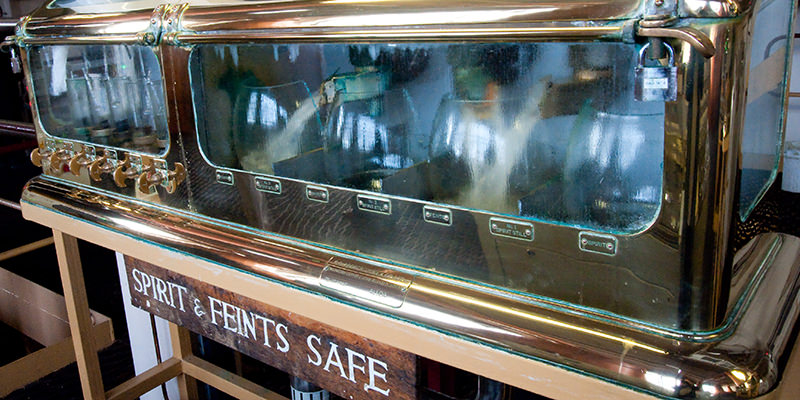“Spirit safe” sounds like just another way of describing this kind of “custom made storage facility.” In fact it has a lot to do with the evolution of Scotch whisky distilling, from regional power shifts to the improvement of “cutting” to a 19th Century crackdown on illegal practices in the Scotch whisky trade.
But let’s take a step back here, since most of us don’t know the ins and outs of whisky distilling and terminology, and since The Bachelor Season 20 started, we’ve all gotten rusty on 19th Century Scotch production law. The rough cut, so to speak: whisky is made from a fermented mash of grains (e.g. barley). By malting the barley, you make its starches more accessible for sugar conversion and then everyone’s favorite chemical formula: fermentation. Basically, that gives you a beer. A thick, intense, ancient-seeming beer. But it’d work in a pinch.
To get a whisky from that beer, you need to distill it. And distilling, believe it or not, comes from the Middle East, and began as a medicinal interest, with highly skilled polymaths working on the creation of the alembic still—not at all anticipating the thirsty primal cry of the future. The way distilling works (told in a bit more detail here) is by taking advantage of the different boiling points of water and alcohol—alcohol burns off sooner (which is why you can use red wine in a dish and not get wasted, which is really, really too bad). Alcohol is evaporated and recondensed into liquid—entirely clear—booze.
Except not all of said booze is created equal. The earliest evaporations and the latest evaporations are called “heads” and “tails,” and they can contain less than desirable chemical accompaniments. The art of distillation is timing the “cuts,” i.e. when to start keeping (and stop keeping) the good stuff. And that’s where the beauty of the spirit safe comes in.
Looking like a glitzed out fish tank done in the fashion of Steam Punk paranoia, the spirit safe is quite literally a safe—there’s a padlock on it, harkening back to the days when only the Customs & Excise (tax man) officer could unlock it. (This was to prevent illegal siphoning, and selling, of whiskey.) But it also allows the distiller to observe the spirit as it’s distilled—thus improving the accuracy of the cuts. It was invented by a guy named Septimus Fox in the 1820s, but made mandatory in 1823, when the Excise Act basically changed the Scotch whisky industry as we know it, or would have known it if we were illegal Scotch distillers. Think of legalized medical marijuana—it doesn’t just mean growers keep on growing. It means the government gets a take, and there’s oversight. Including the spirit safe.
One immediate benefit, the laws enabled smaller Highland distilleries to have their shot at competing with the Big Bad (but awesome, we love you Auchentoshan) Lowland distilleries. Not that this was the historical beginning of whisky licensing in Scotland. But it was the most resounding, pivotal. Of course, being able to open a market legally is great, but it comes with its pitfalls, e.g., compliance to certain entirely important safety and tax standards. The spirit safe prevented the aforementioned siphoning, meaning nobody could lift the good stuff (mainly, the heart of the distillate) before taxes were paid on it. By the way, sh*t, it’s tax season isn’t it?
If you want to know the technical aspects of how a spirit safe works, the Highlands Glenlochy Distillery has an illustrated explanation. The main points, again, are enabling both limited access to the distillate and measuring equipment so as to make the appropriate cuts (alcohol percentages, congeners, etc., all guaranteed to yield you delicious whisky) but also to keep access to the spirit under literal lock and key—like a mom smacking your hand when you open the oven and try to take out an unfinished cookie.
Where Scotch is concerned anyway, up until 1983, the Customs & Excise officer actually kept a hold on the key to the spirit safe. These days, it’s held by the distiller typically. And it should be noted, Scotch isn’t the only whisky that uses the spirit safe. Bourbon producers also use them. And if we’re being at all HGTV here, the look of the spirit safe absolutely compliments the burnished rustic aesthetic of bourbon production.

